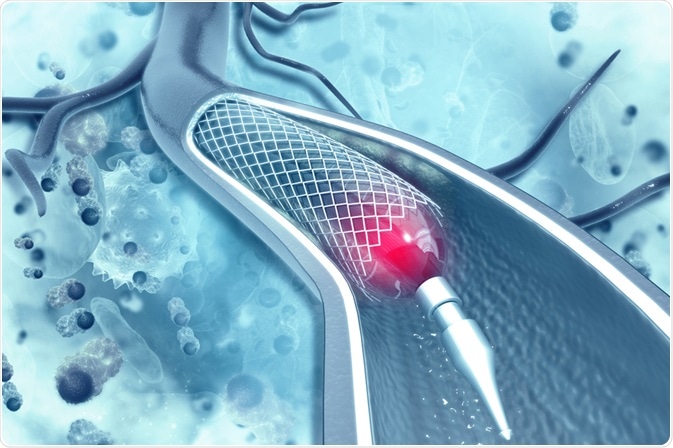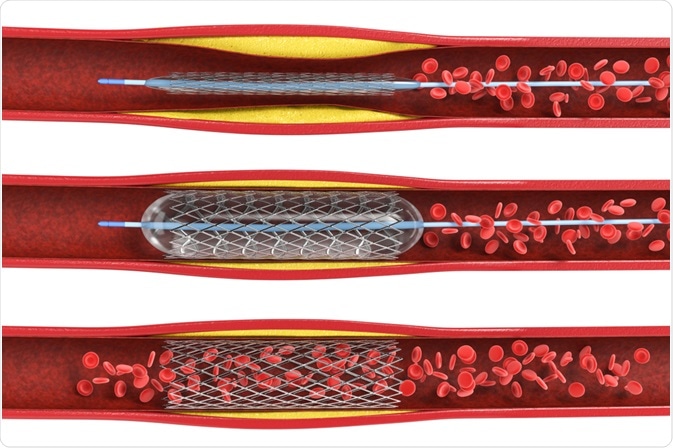Restenosis, a narrowing of blood vessels following angioplasty or stent placement is seen in up to 50% of patients. Cases are treated with various options, including drugs, mechanical devices such as stents, genetic treatment such as gene transfer or infusion of stem cells, and combinations of the above.
 Image Credit: crystal light / Shutterstock.com
Image Credit: crystal light / Shutterstock.com
Recurrent stenosis may occur after balloon angioplasty or after stent placement. If restenosis follows balloon angioplasty, in many cases it is treated by placing a drug-eluting stent into the blocked vessel. After stent placement, restenosis is more challenging to treat.
When a stent becomes blocked, treatment varies depending on many factors. Some of the factors which determine the treatment of a restenosis inside a stent are:
- Where the blocked stent is located
- How severe the blockage is
- The patient’s medical condition and age
- Any coexisting medical illnesses
- The type of heart disease
- The type of stent used previously – bare-metal stent or drug-eluting stent
Treatment options may be surgical or medical.
Surgical treatment
This consists of either repeated percutaneous angioplasty or open surgery.
Restenosis with a bare-metal stent
- In case of an incomplete block, antegrade angioplasty may be performed. Here the catheter with a balloon is guided forward across the block.
- In case of a complete block, retrograde angioplasty is recommended, where the catheter must be inserted backwards into the artery from a collateral vessel. Collaterals are new alternate-route vessels that develop to maintain the circulation to the heart after the block of the usual artery.
- For short blocks, balloon angioplasty, or cutting angioplasty using tiny blades attached to the balloon tip, are used to clear the restenosis. These flatten out scar tissue, or cut through the block, respectively, as well as expand the stent already placed, if present. Cutting angioplasty has the least chance of damage to the vessel wall.
- Repeat stenting with a bare-metal stent is superior to balloon angioplasty alone, especially when done electively, in large arteries and when restenosis occurs at the edge of a stent.
Restenosis with a drug-eluting stent
This is a rare condition and difficult to treat. Recommendations vary from restenting with a different type of drug-eluting stent to using a drug-eluting balloon.
- If restenosis occurs in one type of drug-eluting stent, the placement of the stent must be checked.
- If placement is correct, and it is well-expanded, it is best to switch to another type of drug-eluting stent.
- If the stent is malapposed, it must be properly placed and expanded.
- In some cases, a bypass graft using the patient’s own veins is used to treat the restenosis inside a stent.
- Drug-eluting balloon therapy has been recently shown to have at least equally good results as drug-eluting stents.
Medical treatment
Medical treatment with drugs can be either systemic or targeted to the blocked or treated artery. In all cases, stent placement or angioplasty should be followed up by antiplatelet therapy for periods ranging from weeks to months.
 Image Credit: Phonlamai Photo / Shutterstock.com
Image Credit: Phonlamai Photo / Shutterstock.com
Categories of anti-restenotic drugs
There are several categories of drugs used to prevent or treat restenosis:
- Drugs that inhibit coagulation, such as anticoagulants, antithrombotic agents and antiplatelet agents like clopidogrel and heparin
- Anti-inflammatory agents such as dexamethasone and tranilast
- Drugs that inhibit proliferation and oppose growth factors, such as ACE inhibitors, trapidil, tyrphostin
- Cytostatic drugs, which inhibit smooth muscle cell and inflammatory cell proliferation, like paclitaxel and rapamycin
- Lipid-lowering agents such as statins
- Antioxidants such as probucol or resveratrol
Targeted treatments
Targeted treatment is always preferable over systemic treatment, because of the following advantages:
- Lower side-effects
- Lower dosage
- No need for repeated doses
Targeted treatments for restenosis include:
- Drug-eluting stents
- Perivascular delivery which delivers the drug into the space around the artery
- Delivery catheters
Drug-eluting stents
Drug-eluting stents release stenosis-inhibiting drugs over weeks or months to prevent reactions to the stent. They are usually used where restenosis occurs in a bare-metal stent. They represent one targeted or local treatment form, but they have disadvantages.
Disadvantages of drug-eluting stents include:
- High cost
- Safety not completely proven
- Often cause inflammation due to bio-incompatibility
- Hypersensitivity is an issue with some patients
- Not suitable for all lesions
- The amount of drug that can be applied to them is limited
- Can be associated with stent malapposition
- Endothelial dysfunction or de-endothelialization due to drug release are chronic complications
- Increased risk of late stent thrombus formation and death after antiplatelet therapy stops or following non-compliance with treatment
- Require long-term drug treatment to prevent thrombus formation
Vascular brachytherapy
Vascular brachytherapy is effective in reducing the rates of restenosis. It is hence useful to prevent or treat a restenotic lesion. Here, short-range beta or gamma-ray ionizing therapy is used to inhibit neointimal hyperplasia, so as to prevent shrinkage of the arterial lumen after angioplasty. The radiation produces:
- Inhibition of smooth muscle cell proliferation
- Increased number of cells that enter the apoptosis pathway
- Less fibrosis
- Less negative remodeling
Characteristic changes in irradiated vessels include:
- Persistent absence of endothelium over the irradiated part of the vessel
- Fibrin deposition over the bare area
- Inflammatory cell infiltration of the vessel wall
Vascular brachytherapy can be used alone or following angioplasty of a restenotic lesion. This is performed through a special catheter placed for 10 minutes inside the blocked segment, and containing a source of short-term radiation. It is often used after cutting angioplasty, and before placing a drug-eluting stent. It has certain disadvantages, however, such as:
- Requires highly complex and sophisticated equipment
- Late thrombus formation and stent blockage
- Requires prolonged antiplatelet therapy
- Late restenosis
Excimer laser
This technique of excision has also been used to mitigate the block inside the stent in restenosed arteries. It has high recurrence rates, however, and is rarely used.
References
Further Reading